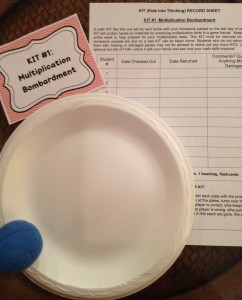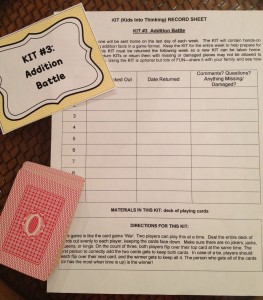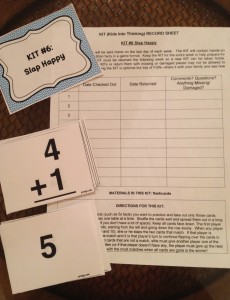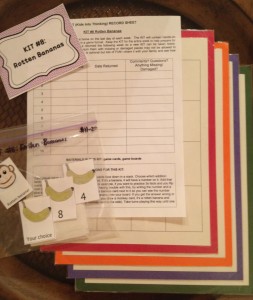A fun way for kids to practice math facts at school or home!
KIT stands for “Kids Into Thinking”. These math KITs are a great way for children to practice basic operations at school and/or home using a different game (in a kit) each week. Learn to create and introduce KITs and download free multiplication KITs below.

FAQs About KITs
- Why do students need math KITs?
Most teachers focus on higher-level thinking activities in class and have little time they can dedicate to rote fact practice and times table memorization. And yet we know that students aren’t going to get proficient with multiplication unless they study and practice, and the Common Core State Standards (CCSS) place strong emphasis on speed and accuracy with core facts.
Memorizing the multiplication tables often becomes a homework task, and it’s tough to get students engaged in it. Few students have the self-discipline to drill themselves with flash cards. Computer-based fact practice is good, but not all students have access to computers and high speed internet.
I created the KITs to provide a fun way for students to practice multiplication facts at home. It’s something enjoyable they can do with their parents as a family (or with siblings, cousins, neighbors, or friends.) As teachers, we can’t force kids to memorize multiplication facts, but we can support our students in every possible way and make it as easier for them.
I provided flashcards and website recommendations, and then sent home KITs for ten weeks each school year so that my students had lots of options for learning their facts.
- What materials are needed?
The games use simple, inexpensive or free, easy-to-obtain materials. You will need to make a minimal amount of photocopies.
- Which skills can be practiced with KITs?
The KITs featured on this page are designed for multiplication facts. (I am in the process of making addition and subtraction KITs, as well, which should be ready by mid-November 2012.) Each KIT can be used for one or more multiplication tables at a time, depending on which flashcards and materials are chosen by the student.
- What containers do I need?
To hold the KITs, I used zip-close baggies for the smaller materials and the boxes that Scholastic book orders come in to keep the whole KIT together. Instead of the book order boxes, you could use shoe boxes, plastic containers or tubs, mini backbacks, or anything else you have available.
- How do students use the record sheets?
I printed the KIT directions/record sheets and stuck them inside the KITs with the materials that are listed on the forms. Since I had 20 students and only 10 different KITs, I made two of each KIT. Students #1-10 shared one set of KITs, and students #11-20 shared the other set of KITs. If you have more than 20 students, you could make additional KITs using other math games you have or make a third set of the games for students #21-30 to share.
- How do you distribute and collect the KITs each week?
Each Friday, my students returned their old KIT and signed out a new one. I called 10 students at a time over to a table (specifically, the ten kids who shared one set of KITs, so #1-10 all at once and then #11-20 all at once). Then I quickly checked to make sure no materials were missing or damaged, and let them pick out new KITs from the selection on the table.
Since the children signed their names on the record sheets inside the KITs, they could just check the sheet if they weren’t sure whether they’d tried a particular KIT yet. KITs were checked out weekly until each child had a chance to use every KIT (ten weeks). Students used them to practice whichever multiplication table we were currently studying (there was an in-school quiz weekly).
- What if kids don’t return the KITs?
I had several instances in which materials were lost or damaged. However, because the items were not expensive, and I knew that most of my kids were actually using the KITs, I didn’t mind having to replace things periodically. It’s a good idea to have an extra set of KITs (or at least KIT materials) so that you can immediately replace them when needed. You’ll need to determine for yourself whether your students will responsibly use the materials and transport them safely to and from school, but I encourage you to take a leap of faith and give your students the opportunity to prove themselves. If you stress to your kids that these KITs are very special and you spent a long time making them all yourself so they would have a fun way to learn math facts, most children will try to take very good care of them. Also, students know cannot check out a new KIT until the old one is returned, and that’s a pretty good incentive, too.
- Who plays the KIT games with the students at home?
Children can play the KIT games with other children or adults. Since they keep the same KIT for an entire week (including the weekend), they have plenty of opportunities to invite friends or neighbors over, play with cousins or siblings, etc. Most games can accommodate up to 4 players. The two player games are indicated as such in their directions.
- Do I grade students on their KIT usage?
The KITs are just an opportunity for students to practice math facts and therefore I chose not to assess them. I gave weekly multiplication quizzes in class and that was the way I measured students’ growth and progress.
- What are the consequences if students don’t use the KITs?
I didn’t penalize students for not playing as long as they returned the KIT in good condition each week. I like to make KITs a fun privilege and hype them up so much that kids think they’d be crazy not to play. This can be accomplished by making a big deal out of collection time: “Ok, it’s Friday! Time for new KITs! Woo-hoo! Who had a great time playing this week? Tell us who you played with! Fun! Which game is your favorite so far? Which one would you like to get today? Boy, I can’t wait to see your scores on the mutiplication test today. All this practicing at home–you guys are gonna rock it for sure!” I know a few kids rarely if ever played, but that’s really out of my control. Getting them to complete regular homework was enough of a chore; for me, it just wasn’t worth getting upset if they didn’t want to play a math game.
- How do I introduce KITs to my class?
Explain that you’ve created a fun way for them to practice their math facts at home, and that they’ll be able to try out the KITs in class first. If you want, tell students you’ll be watching how they use the KITs in class and will make a determination based on their practice regarding whether they’ll be allowed to take the KITs home. (The purpose of this statement is to get kids to view the games as a privilege and not a chore, and incentivize them to concentrate on their learning and use the materials correctly.)
There are 10 games, if you pair students up everyday, it will take 2 weeks for students to rotate through all the KITs. Give each pair a different KIT each day and have them explore the directions and materials together for 7-10 minutes. As you watch the pairs play, be sure to correct any misconceptions and check that students are caring for and cleaning up the materials properly. Afterward, take a moment to model correct/incorrect usage of KITs and/or allow a particularly responsible pair of students to demonstrate how they played and cleaned up.
Once the class has had a chance to explore every KIT under your supervision, begin allowing them to take the games home. At that point, they should be familiar with the activities and excited to show them off at home.
- What if I don’t have time to let the kids practice with the KITs in class before sending them home?
You can skip the in-class practice period, but taking the time to properly model and guide students through practice will save you a lot of headache once students start taking the materials home. The experience will also be more valuable for them because they’ll be more likely to use the games if they’ve had a positive experience with them and have been taught to play the games correctly.
- How many weeks should I use the KITs?
I sent home one KIT per week for ten weeks. After that, the KITs were added to my math centers and students were able to play them in class if they wanted. A few parents requested that the KITs be sent home again at the end of the school year as a refresher and I accommodated their request. Often children would ask to borrow specific KITs throughout the year and I allowed that, as well.
- How long does it take to make the KITs?
It took me about 2 hours to gather all the materials, print everything out, and organize the KITs. Not bad for something my students used every single night for weeks! I was able to use the same set of KITs again the following two school years.
- I want to get started! How do I create the KITs?
After numerous requests, I have finally made a printable set of multiplication KITs and addition KITs! Each download is 171 total pages and is available for $4.50. They include the recording sheets with directions for each KIT, instructions for making the KITs, game boards and game cards, and more. You can download a free preview to see everything that’s included before you buy.
Addition and multiplication fact practice games in the KITs
Here are a few examples of the KITs I’ve made. The same games can be used for addition and multiplication with minor adaptations. If you want to use both KITs, I recommend using the addition KITs during the first semester and multiplication KITs in the second semester. I’ve found that students enjoy playing familiar games and seeing them adapted for different operations. Another bonus that comes from using the same games for addition and multiplication is that you will need to spend very little time creating the second set of KITs because you already have all the materials gathered. Introducing the games to students and teaching them how to care for the KITs the second time around will also be much quicker.





Get the printable set of KITs!
After numerous requests, I have finally made a printable set of multiplication KITs and addition KITs! Each download is 171 total pages and is available for $4.50. They include the recording sheets with directions for each KIT, instructions for making the KITs, game boards and game cards, and more. You can download a free preview to see everything that’s included before you buy.
Printable math centers
I’m currently creating even more sets of math partner games! If you don’t have the time and energy to make your own centers, just print these out–they’re ready to use!
This project began in December 2012. In the coming months, my plan is to make math games for every Common Core domain for grades 1-5 (Operations and Algebraic Thinking, Number and Operations in Base Ten, Fractions,Measurement and Data, and Geometry.) Below are the printables I have made so far. To receive an email notification when new skills and grade levels are added, follow my store on TeachersPayTeachers! Thank you for your support.

Angela Watson
Founder and Writer
Discussion
Leave a Reply
OR

Join our
community
of educators
If you are a teacher who is interested in contributing to the Truth for Teachers website, please click here for more information.
















Angela,
Thank you for your site!!! It has renewed my teaching passion. I want to start doing math centers with my 3rd graders this year. Thank you for all your center ideas. I read all the downloadable directions, but some of them require gameboards (in the centers and KITS) and I don’t see them anywhere. I found some materials (memory cards, etc.) on the Flashcard Exchange, but I would love the gameboards so that I can make my own math centers. Is there anyway you could pass them along or tell me where to find them?
Noticed gameboards needed for:
Big 3 Digit, Baby 3 Digit, 3 Card Zero, 10 frames, 50 wins (die directions), FACTO, Subtraction Track, Place Value Game, plus some that you have pictured on your site.
Thank you for your insite into the profession and for your willingness to share ideas!
Hi, Melissa! All the materials needed for the KITs are linked to on the KITs page, so you’re good to go with those. For the math games page, I only have hard copies of the games you mentioned, so I don’t have gameboards to share, unfortunately! I’m going to try to make and upload them, though…stay tuned. 🙂
Love your site. Please change the background (navy) to a lighter color so your wonderful words of wisdom are easier to see!
Hi, Tina! The background is actually white. Only the border is navy. If you are seeing the entire page in navy, it means the website has not fully loaded on your computer and/or your browser needs to be updated to the latest version. Try visiting the site from a different computer or with a high speed internet connection and see if that fixes the problem. 🙂
AHHHHHH! You are fabulous! Thanks for sharing and helping my (3x weekly) math center, “Fact Practice.”
LOL, thanks so much, Amy! I appreciate the time you took to comment. 🙂 Enjoy!
hiiiiiiii, omg love your kits they’re amazing and help a lot to everyone. oh your an amazing person lol